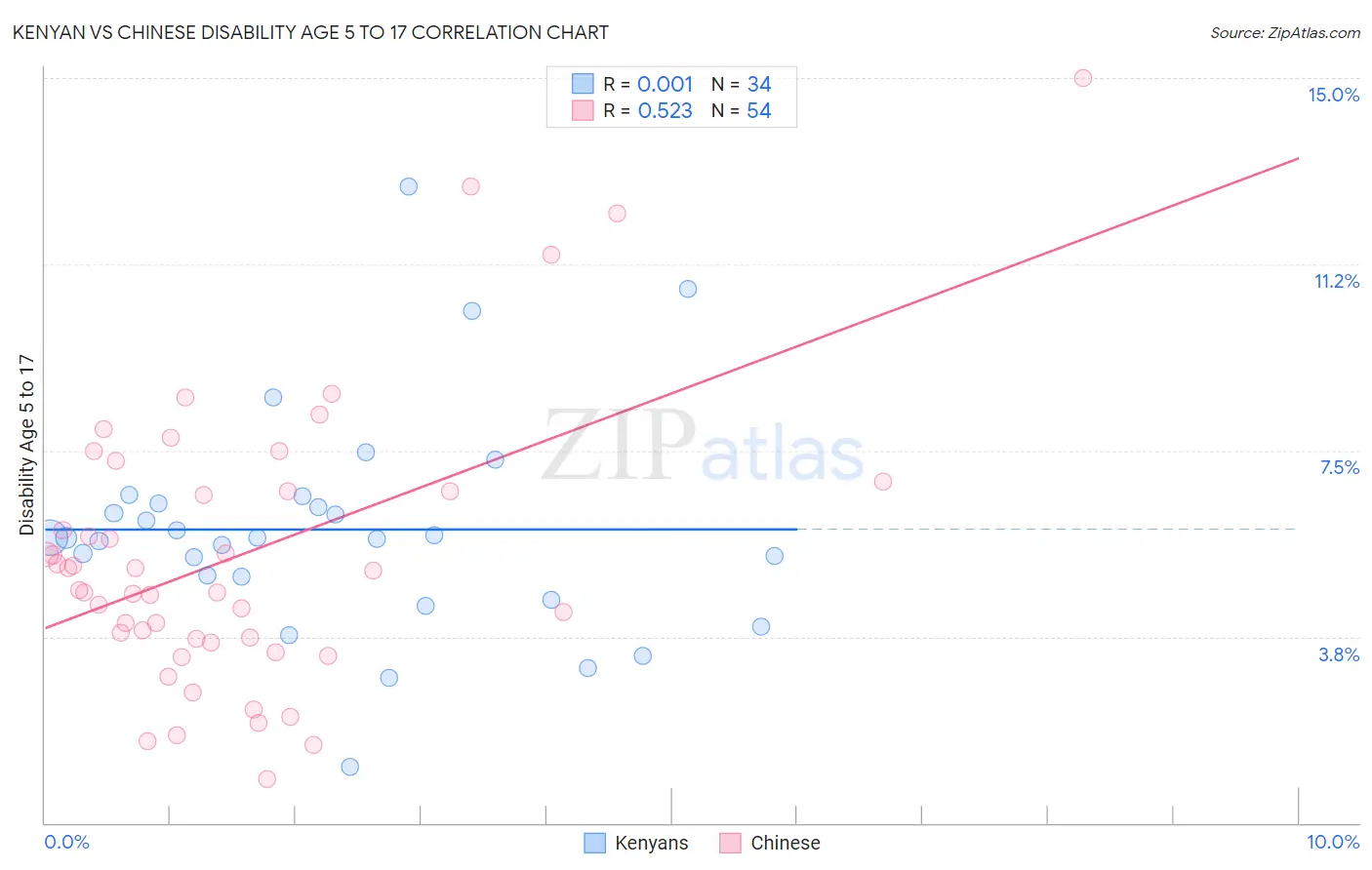Kenyan vs Chinese Disability Age 5 to 17
COMPARE
Kenyan
Chinese
Disability Age 5 to 17
Disability Age 5 to 17 Comparison
Kenyans
Chinese
5.8%
DISABILITY AGE 5 TO 17
10.0/ 100
METRIC RATING
208th/ 347
METRIC RANK
4.7%
DISABILITY AGE 5 TO 17
100.0/ 100
METRIC RATING
15th/ 347
METRIC RANK
Kenyan vs Chinese Disability Age 5 to 17 Correlation Chart
The statistical analysis conducted on geographies consisting of 167,701,588 people shows no correlation between the proportion of Kenyans and percentage of population with a disability between the ages 5 and 17 in the United States with a correlation coefficient (R) of 0.001 and weighted average of 5.8%. Similarly, the statistical analysis conducted on geographies consisting of 64,726,058 people shows a substantial positive correlation between the proportion of Chinese and percentage of population with a disability between the ages 5 and 17 in the United States with a correlation coefficient (R) of 0.523 and weighted average of 4.7%, a difference of 22.5%.

Disability Age 5 to 17 Correlation Summary
| Measurement | Kenyan | Chinese |
| Minimum | 1.1% | 0.88% |
| Maximum | 12.8% | 15.0% |
| Range | 11.7% | 14.1% |
| Mean | 5.9% | 5.4% |
| Median | 5.7% | 4.9% |
| Interquartile 25% (IQ1) | 5.0% | 3.7% |
| Interquartile 75% (IQ3) | 6.4% | 6.7% |
| Interquartile Range (IQR) | 1.5% | 3.0% |
| Standard Deviation (Sample) | 2.2% | 2.9% |
| Standard Deviation (Population) | 2.2% | 2.8% |
Similar Demographics by Disability Age 5 to 17
Demographics Similar to Kenyans by Disability Age 5 to 17
In terms of disability age 5 to 17, the demographic groups most similar to Kenyans are Immigrants from Uganda (5.8%, a difference of 0.040%), Moroccan (5.7%, a difference of 0.050%), Immigrants from Haiti (5.8%, a difference of 0.070%), Trinidadian and Tobagonian (5.7%, a difference of 0.10%), and Immigrants from Africa (5.7%, a difference of 0.10%).
| Demographics | Rating | Rank | Disability Age 5 to 17 |
| Basques | 13.7 /100 | #201 | Poor 5.7% |
| Austrians | 13.2 /100 | #202 | Poor 5.7% |
| Spanish American Indians | 12.8 /100 | #203 | Poor 5.7% |
| Paiute | 11.2 /100 | #204 | Poor 5.7% |
| Trinidadians and Tobagonians | 10.8 /100 | #205 | Poor 5.7% |
| Immigrants | Africa | 10.8 /100 | #206 | Poor 5.7% |
| Moroccans | 10.4 /100 | #207 | Poor 5.7% |
| Kenyans | 10.0 /100 | #208 | Poor 5.8% |
| Immigrants | Uganda | 9.7 /100 | #209 | Tragic 5.8% |
| Immigrants | Haiti | 9.5 /100 | #210 | Tragic 5.8% |
| Yugoslavians | 9.1 /100 | #211 | Tragic 5.8% |
| Immigrants | Panama | 8.7 /100 | #212 | Tragic 5.8% |
| Immigrants | Cameroon | 8.3 /100 | #213 | Tragic 5.8% |
| Immigrants | Morocco | 8.3 /100 | #214 | Tragic 5.8% |
| Swedes | 8.1 /100 | #215 | Tragic 5.8% |
Demographics Similar to Chinese by Disability Age 5 to 17
In terms of disability age 5 to 17, the demographic groups most similar to Chinese are Immigrants from Korea (4.7%, a difference of 0.20%), Immigrants from Singapore (4.7%, a difference of 0.42%), Arapaho (4.7%, a difference of 0.88%), Immigrants from South Central Asia (4.7%, a difference of 0.90%), and Thai (4.7%, a difference of 0.91%).
| Demographics | Rating | Rank | Disability Age 5 to 17 |
| Indians (Asian) | 100.0 /100 | #8 | Exceptional 4.6% |
| Immigrants | Eastern Asia | 100.0 /100 | #9 | Exceptional 4.6% |
| Immigrants | India | 100.0 /100 | #10 | Exceptional 4.6% |
| Armenians | 100.0 /100 | #11 | Exceptional 4.6% |
| Iranians | 100.0 /100 | #12 | Exceptional 4.6% |
| Thais | 100.0 /100 | #13 | Exceptional 4.7% |
| Immigrants | Korea | 100.0 /100 | #14 | Exceptional 4.7% |
| Chinese | 100.0 /100 | #15 | Exceptional 4.7% |
| Immigrants | Singapore | 100.0 /100 | #16 | Exceptional 4.7% |
| Arapaho | 100.0 /100 | #17 | Exceptional 4.7% |
| Immigrants | South Central Asia | 100.0 /100 | #18 | Exceptional 4.7% |
| Immigrants | Uzbekistan | 100.0 /100 | #19 | Exceptional 4.8% |
| Burmese | 100.0 /100 | #20 | Exceptional 4.8% |
| Yup'ik | 100.0 /100 | #21 | Exceptional 4.8% |
| Asians | 100.0 /100 | #22 | Exceptional 4.8% |